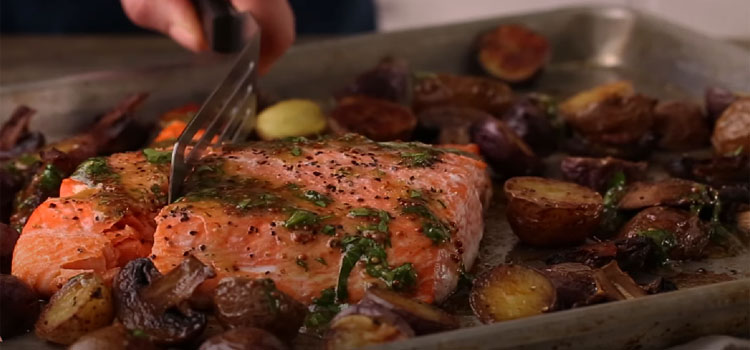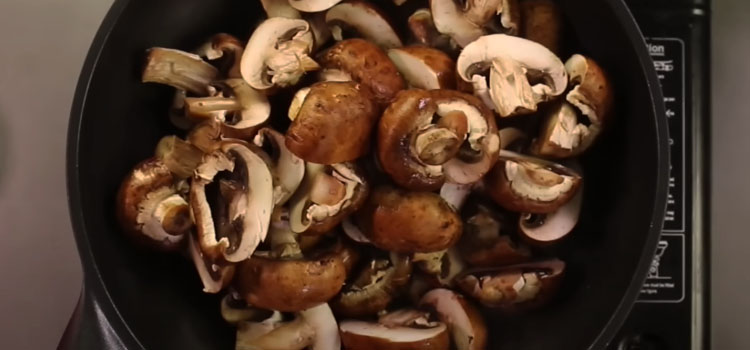Last Updated on September 16, 2024 by Shari Mason
Savoring slow-roasted salmon paired with a tasty mushroom-leek broth fills me with delight. This dish feels like a gourmet adventure, mixing flavors and textures into a tasty harmony.
Crafting this dish requires a careful orchestration of flavors, and understanding the process allows you to savor a symphony of tastes that unfold with every bite. Read on for my special recipe.
Slow-Roasted Salmon With Mushroom Leek Broth Recipe


Ingredients:
For the Salmon:
- 4 salmon fillets
- Salt and pepper, to taste
- Olive oil
For the Mushroom-Leek Broth:
- 1 cup sliced mushrooms (such as cremini or shiitake)
- 1 leek, cleaned and thinly sliced
- 2 tablespoons butter or olive oil
- 2 cloves garlic, minced
- 4 cups chicken or vegetable broth
- 1 teaspoon fresh thyme leaves
- Salt and pepper, to taste
Instructions:
- Preheat the Oven: Preheat your oven to 275°F (135°C).
- Prepare the Salmon: Pat the salmon [1] fillets dry with paper towels—season both sides with salt and pepper. Drizzle a bit of olive oil over the fillets.
- Sear the Salmon: Heat a skillet over medium-high heat. Once hot, add a drizzle of olive oil. Sear the salmon fillets for about 2 minutes on each side until they get a golden crust. Remove from the skillet and set aside.
- Prepare the Broth: In the same skillet, melt butter (or heat olive oil) over medium heat. Add the sliced leeks and sauté for about 2 minutes until they soften. Add the sliced mushrooms and minced garlic, and cook for another 3-4 minutes until the mushrooms are tender.
- Create the Broth Base: Pour the chicken or vegetable broth and add fresh thyme leaves. Let the broth simmer for 15-20 minutes, melding the flavors together—season with salt and pepper to taste.
- Slow-Roast the Salmon: Place the seared salmon fillets in an oven-safe dish. Gently pour the prepared mushroom-leek broth over the salmon. Cover the dish with aluminum foil.
- Roast in the Oven: Place the covered dish in the oven and slow-roast the salmon for about 20-25 minutes, or until the salmon is cooked to your preferred level of doneness and flakes quickly with a fork.
- Serve and Enjoy: Carefully remove the dish from the oven. Serve the slow-roasted salmon fillets in bowls, spooning the flavorful mushroom-leek broth. Garnish with additional fresh thyme leaves if desired.
Also Read:
- How Much Salmon Per Person?
- How To Cook Salmon In A Toaster Oven?
- Can You Eat Store-Bought Salmon Raw?
What’s The Essence Of Slow-Roasted Salmon?
The essence of slow-roasted salmon lies in its systematic cooking approach that results in a delicate and tender texture.
Unlike traditional high-heat methods, slow-roasting involves gently cooking the salmon at a lower temperature over a more extended period.
“I work on most weekends, so my husband is the executive chef. He is an amazing cook. I love the way he does salmon, and his apple pie for dessert is delicious.”
– Erica Durance, Canadian Actress
This gradual cooking process preserves the natural moisture within the fish, ensuring it remains succulent and almost melts in your mouth.
As the salmon slowly cooks, it absorbs the flavors of any accompanying elements, like a mushroom-leek broth, resulting in a harmonious fusion of taste and tenderness that’s genuinely indulgent.x
What Role Do Mushrooms & Leeks Play?


Mushrooms [2] and leeks are pivotal in enhancing the dish’s flavor profile.
The earthy and slightly sweet notes of mushrooms harmonize with the delicate richness of the salmon, creating a depth of taste that’s both comforting and satisfying.
With their mild onion-like flavor, Leeks provide a gentle aromatic undertone to the broth, infusing it with subtle layers of complexity.
Together, these ingredients elevate the slow-roasted salmon, forming a balanced and flavorful culinary symphony that delights the palate with every bite.
Why Choose Slow-Roasting?
Opting for slow-roasting when preparing salmon offers a range of culinary benefits that elevate the dish’s taste and texture.
Unlike higher-temperature cooking methods that can risk overcooking and drying out the fish, slow-roasting at a lower temperature preserves the natural moisture and tenderness of the salmon.
“In the quiet embrace of slow-roasting, salmon and broth become symphony partners, their flavors harmonizing with patience, creating a culinary masterpiece that speaks to the senses.” –
Eat Pallet Restaurant & Food Advice
This method allows the flavors to infuse gradually, ensuring a gentle fusion of taste between the salmon and the accompanying mushroom-leek broth.
FAQs
u003cstrongu003eCan I use different types of fish for this dish? u003c/strongu003e
Yes. While the recipe highlights salmon, you can experiment with cod, trout, or halibut. u003cbru003eu003cbru003eRemember that different fish may have varying cooking times, so adjust to ensure they are cooked perfectly.
u003cstrongu003eWhat can I serve alongside this dish? u003c/strongu003e
Slow-roasted salmon with mushroom-leek broth pairs well with a variety of sides. Consider serving it with steamed vegetables, roasted potatoes, or a simple green salad. u003cbru003eu003cbru003eThe mild flavors of the dish make it versatile enough to complement various sides, allowing you to create a well-rounded and satisfying meal.
In Conclusion
In gastronomy, the journey of slow-roasted salmon with mushroom-leek broth emerges as a testament to the artistry of flavor.
The meticulous combination of tender salmon and the nuanced embrace of the broth reflects the craft of culinary balance.
Each bite encapsulates a symphony of textures and tastes that unfold leisurely, resonating with the senses.
By understanding the essence of slow-roasting, appreciating the roles of mushrooms and leeks, and crafting the broth with care, you embark on a culinary expedition that celebrates the beauty of simplicity and the elegance of taste.
References:
- https://www.healthline.com/nutrition/salmon-nutrition-and-health-benefits
- https://www.medicalnewstoday.com/articles/278858
- Can You Put an AC Unit in the Kitchen? - September 27, 2024
- What Cheese Does Olive Garden Use? Discover Their Signature - September 27, 2024
- How to Cancel a Pizza Hut Order? Quick & Easy Guide - September 24, 2024


